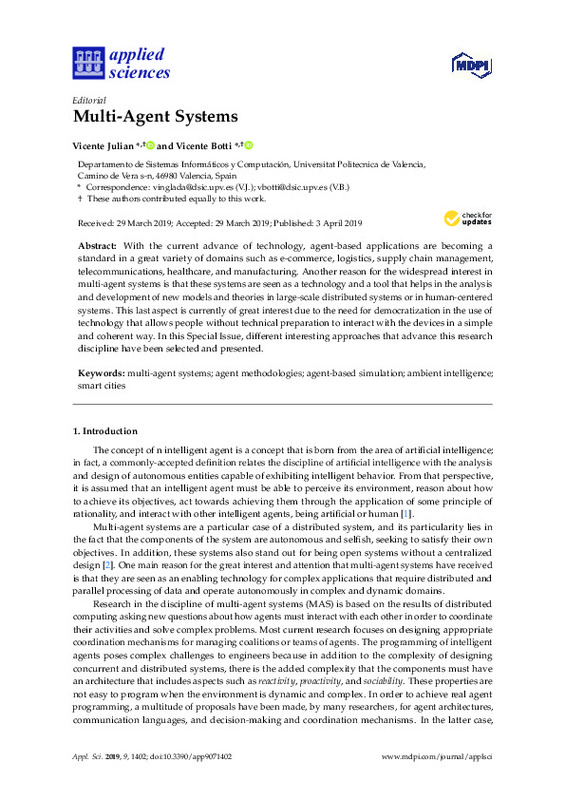Kravari, K., & Bassiliades, N. (2015). A Survey of Agent Platforms. Journal of Artificial Societies and Social Simulation, 18(1). doi:10.18564/jasss.2661
Baldoni, M., Baroglio, C., May, K., Micalizio, R., & Tedeschi, S. (2018). Computational Accountability in MAS Organizations with ADOPT. Applied Sciences, 8(4), 489. doi:10.3390/app8040489
Boissier, O., Bordini, R. H., Hübner, J. F., Ricci, A., & Santi, A. (2013). Multi-agent oriented programming with JaCaMo. Science of Computer Programming, 78(6), 747-761. doi:10.1016/j.scico.2011.10.004
[+]
Kravari, K., & Bassiliades, N. (2015). A Survey of Agent Platforms. Journal of Artificial Societies and Social Simulation, 18(1). doi:10.18564/jasss.2661
Baldoni, M., Baroglio, C., May, K., Micalizio, R., & Tedeschi, S. (2018). Computational Accountability in MAS Organizations with ADOPT. Applied Sciences, 8(4), 489. doi:10.3390/app8040489
Boissier, O., Bordini, R. H., Hübner, J. F., Ricci, A., & Santi, A. (2013). Multi-agent oriented programming with JaCaMo. Science of Computer Programming, 78(6), 747-761. doi:10.1016/j.scico.2011.10.004
Challenger, M., Tezel, B., Alaca, O., Tekinerdogan, B., & Kardas, G. (2018). Development of Semantic Web-Enabled BDI Multi-Agent Systems Using SEA_ML: An Electronic Bartering Case Study. Applied Sciences, 8(5), 688. doi:10.3390/app8050688
Challenger, M., Demirkol, S., Getir, S., Mernik, M., Kardas, G., & Kosar, T. (2014). On the use of a domain-specific modeling language in the development of multiagent systems. Engineering Applications of Artificial Intelligence, 28, 111-141. doi:10.1016/j.engappai.2013.11.012
Boztepe, İ., & Erdur, R. (2018). Linked Data Aware Agent Development Framework for Mobile Devices. Applied Sciences, 8(10), 1831. doi:10.3390/app8101831
Shoham, Y., Powers, R., & Grenager, T. (2007). If multi-agent learning is the answer, what is the question? Artificial Intelligence, 171(7), 365-377. doi:10.1016/j.artint.2006.02.006
Duan, K., Fong, S., Zhuang, Y., & Song, W. (2018). Artificial Neural Networks in Coordinated Control of Multiple Hovercrafts with Unmodeled Terms. Applied Sciences, 8(6), 862. doi:10.3390/app8060862
Zhang, Q., Yao, J., Yin, Q., & Zha, Y. (2018). Learning Behavior Trees for Autonomous Agents with Hybrid Constraints Evolution. Applied Sciences, 8(7), 1077. doi:10.3390/app8071077
Cook, D. J., Augusto, J. C., & Jakkula, V. R. (2009). Ambient intelligence: Technologies, applications, and opportunities. Pervasive and Mobile Computing, 5(4), 277-298. doi:10.1016/j.pmcj.2009.04.001
Kranz, M., Holleis, P., & Schmidt, A. (2010). Embedded Interaction: Interacting with the Internet of Things. IEEE Internet Computing, 14(2), 46-53. doi:10.1109/mic.2009.141
Gershenfeld, N., Krikorian, R., & Cohen, D. (2004). The Internet of Things. Scientific American, 291(4), 76-81. doi:10.1038/scientificamerican1004-76
Atzori, L., Iera, A., & Morabito, G. (2010). The Internet of Things: A survey. Computer Networks, 54(15), 2787-2805. doi:10.1016/j.comnet.2010.05.010
Costa, A., Novais, P., Corchado, J. M., & Neves, J. (2011). Increased performance and better patient attendance in an hospital with the use of smart agendas. Logic Journal of IGPL, 20(4), 689-698. doi:10.1093/jigpal/jzr021
Tapia, D. I., & Corchado, J. M. (2009). An Ambient Intelligence Based Multi-Agent System for Alzheimer Health Care. International Journal of Ambient Computing and Intelligence, 1(1), 15-26. doi:10.4018/jaci.2009010102
Barriuso, A., De la Prieta, F., Villarrubia González, G., De La Iglesia, D., & Lozano, Á. (2018). MOVICLOUD: Agent-Based 3D Platform for the Labor Integration of Disabled People. Applied Sciences, 8(3), 337. doi:10.3390/app8030337
Rosales, R., Castañón-Puga, M., Lara-Rosano, F., Flores-Parra, J., Evans, R., Osuna-Millan, N., & Gaxiola-Pacheco, C. (2018). Modelling the Interaction Levels in HCI Using an Intelligent Hybrid System with Interactive Agents: A Case Study of an Interactive Museum Exhibition Module in Mexico. Applied Sciences, 8(3), 446. doi:10.3390/app8030446
Ramos, J., Oliveira, T., Satoh, K., Neves, J., & Novais, P. (2018). Cognitive Assistants—An Analysis and Future Trends Based on Speculative Default Reasoning. Applied Sciences, 8(5), 742. doi:10.3390/app8050742
SATOH, K. (2005). Speculative Computation and Abduction for an Autonomous Agent. IEICE Transactions on Information and Systems, E88-D(9), 2031-2038. doi:10.1093/ietisy/e88-d.9.2031
Miyashita, K. (2017). Incremental Design of Perishable Goods Markets through Multi-Agent Simulations. Applied Sciences, 7(12), 1300. doi:10.3390/app7121300
Albino, V., Berardi, U., & Dangelico, R. M. (2015). Smart Cities: Definitions, Dimensions, Performance, and Initiatives. Journal of Urban Technology, 22(1), 3-21. doi:10.1080/10630732.2014.942092
Roscia, M., Longo, M., & Lazaroiu, G. C. (2013). Smart City by multi-agent systems. 2013 International Conference on Renewable Energy Research and Applications (ICRERA). doi:10.1109/icrera.2013.6749783
Lozano, Á., De Paz, J., Villarrubia González, G., Iglesia, D., & Bajo, J. (2018). Multi-Agent System for Demand Prediction and Trip Visualization in Bike Sharing Systems. Applied Sciences, 8(1), 67. doi:10.3390/app8010067
Jordán, J., Palanca, J., del Val, E., Julian, V., & Botti, V. (2018). A Multi-Agent System for the Dynamic Emplacement of Electric Vehicle Charging Stations. Applied Sciences, 8(2), 313. doi:10.3390/app8020313
Billhardt, H., Fernández, A., Lujak, M., & Ossowski, S. (2018). Agreement Technologies for Coordination in Smart Cities. Applied Sciences, 8(5), 816. doi:10.3390/app8050816
[-]









